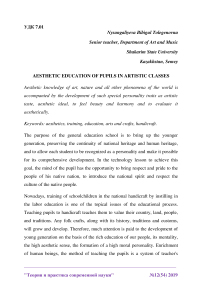Aesthetic education of pupils in artistic classes
Автор: Nysangaliyeva B.T.
Журнал: Теория и практика современной науки @modern-j
Рубрика: Образование и педагогика
Статья в выпуске: 12 (54), 2019 года.
Бесплатный доступ
Aesthetic knowledge of art, nature and all other phenomena of the world is accompanied by the development of such special personality traits as artistic taste, aesthetic ideal, to feel beauty and harmony and to evaluate it aesthetically.
Aesthetics, training, education, arts and crafts, handicraft
Короткий адрес: https://sciup.org/140274217
IDR: 140274217 | УДК: 7.01
Текст научной статьи Aesthetic education of pupils in artistic classes
The purpose of the general education school is to bring up the younger generation, preserving the continuity of national heritage and human heritage, and to allow each student to be recognized as a personality and make it possible for its comprehensive development. In the technology lesson to achieve this goal, the mind of the pupil has the opportunity to bring respect and pride to the people of his native nation, to introduce the national spirit and respect the culture of the native people.
Nowadays, training of schoolchildren in the national handicraft by instilling in the labor education is one of the topical issues of the educational process. Teaching pupils to handicraft teaches them to value their country, land, people, and traditions. Any folk crafts, along with its history, traditions and customs, will grow and develop. Therefore, much attention is paid to the development of young generation on the basis of the rich education of our people, its mentality, the high aesthetic sense, the formation of a high moral personality. Enrichment of human beings, the method of teaching the pupils is a system of teacher's creative approach to artistic workshops. A.Margulan, U.Zhanibekov, H.Argynbayev, S.Kasimanov, G.Ilyaev, A.Galymbayeva, A.Mukanov and others. studied and published many of his works. M. Kozybakov, Sh.Abdualieva, S.Zholdasbekova, B.Ortaev, etc. on the basis of arts and crafts arts. There are many advantages in educating national traditions of pupils by teaching crafts of our people in the classes of technology. In addition to handicraft, creativity, education, traditions and customs of our ancestors, modern requirements. If you discover the secret of the creation of any product, art, or craft, you will be able to get acquainted with the work of the student by introducing the technology of creation of additional literature. Kazakh handicraft is part of artistic culture. This art has been widely used in ancient times since today. Through the acquaintance of Kazakh folk art, the child understands a wide range of movements around the world. The constant presence of the children with their works of art is moral, emotional, is a major support for emotional development and aesthetic views: schoolchildren's art, song, compilation and handicrafts, fiction lessons, morning art and entertainment, acquaintance with the national art of our people, creates artistic taste and personal outlook.
Nowadays, the national handicraft is a product of artistic work in the younger generation.Through the labor, the human body, the attitude, the level of the aesthetic and intelligence develop and mature, the value and value of the work increases. The labor education of children and youth has long been a parent's duty and the task of the whole nation.
One of the priceless treasures of the spiritual and cultural fund of humanity is the crafts and traditions of the people, the people of the people, the psychological and ethnic sense of the soul, reflected in his crafts and traditions. It is clear that the customs and traditions of the people are connected with the change of time after the historical events. This is evidenced by the national practice in the generation of generations. This situation is a part of the national culture, which is an integral part of contemporary culture in terms of interaction with professional art, it is only possible to look at creativity from a specific type. Artistic-creative work based on applied arts is aimed at schoolchildren activity, fostering imagination and imagination. For example, the ornaments, insights and concepts of the people in decorative and applied art, the conclusions, the outlook of the people, improve the aesthetic qualities of the individual. Colors and the harmony of the material, the shape and patterns, their beauty and harmony, influence the human minds and enrich their spirituality.
Used sources:
-
1. Kasimanov S. «Crafts of the Kazakh people». Almaty,1995.
-
2. Abdygapbarova U.М. «Training students for the use of Kazakh national ornament in educating students». Almaty,1998.
-
3. D. Shokparuly, D. Darkembayuly «Kazakhs аpplied аrt». Almaty, 2007.
-
4. Argynbayev Kh. «The Kazakh people's handicraft», Almaty.
-
5. Zharykbaev K. «Kazakh education», Almaty.
Список литературы Aesthetic education of pupils in artistic classes
- Kasimanov S. "Crafts of the Kazakh people". Almaty,1995.
- Abdygapbarova U.М. "Training students for the use of Kazakh national ornament in educating students". Almaty,1998.
- D. Shokparuly, D. Darkembayuly "Kazakhs аpplied аrt". Almaty, 2007.
- Argynbayev Kh. "The Kazakh people's handicraft", Almaty.
- Zharykbaev K. "Kazakh education", Almaty.


